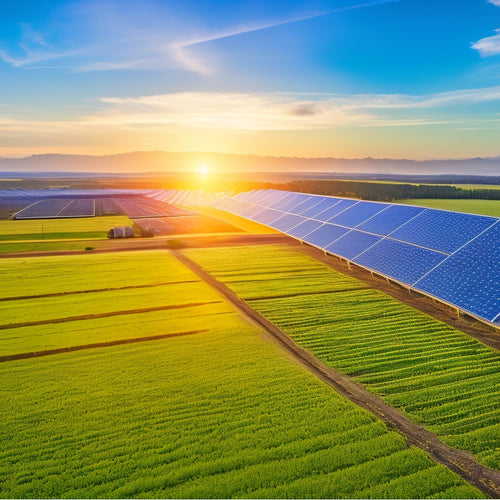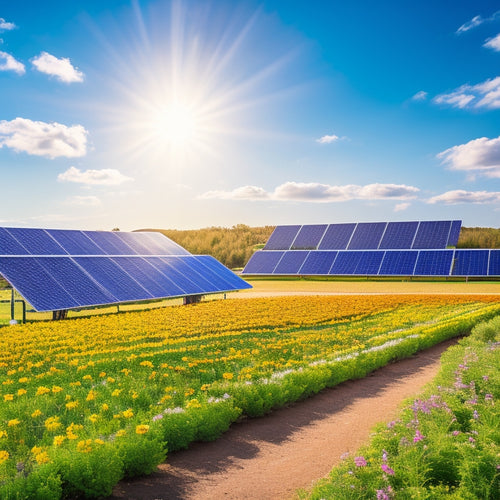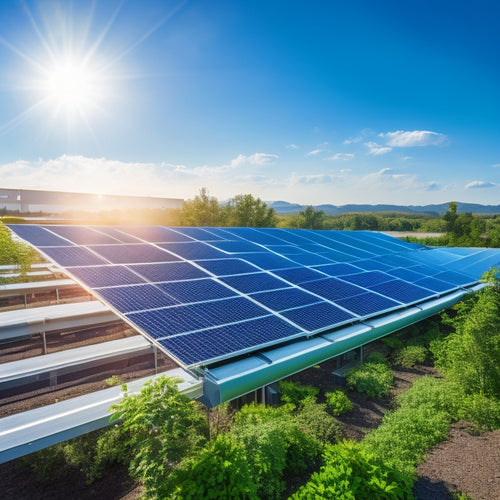
10 Solar Panel Negatives to Consider Before Investing
Share
When considering solar panels, you'll want to weigh the pros and cons. On the downside, high upfront installation costs, energy storage expenses, and battery replacement needs can be significant. Solar panels also have limitations, such as being an intermittent energy source, converting sunlight inefficiently, and losing energy over time. Aesthetically, they can affect your home's curb appeal, and their production and disposal can pose environmental risks. Additionally, weather conditions impact their performance, and maintenance is essential to guarantee maximum energy output. Understanding these potential negatives will help you make an informed investment decision - and there's more to investigate.
Key Takeaways
- High upfront installation costs and energy storage expenses can deter homeowners and businesses from adopting solar panels.
- Solar panels do not generate electricity at night or during cloudy days, requiring reliance on traditional power sources.
- Solar panels contain hazardous materials and improper disposal can lead to toxic material leakage into soil and water sources.
- Regular maintenance is crucial to ensure maximum energy absorption, and weather conditions can significantly influence solar panel performance and efficiency.
- Battery replacement and maintenance costs can accumulate over time, and environmental implications of battery disposal should be considered in planning.
High Upfront Installation Costs
With solar panels, one of the most notable obstacles to overcome is the high upfront installation cost, which can be a major deterrent for many homeowners and businesses.
However, you shouldn't let this initial expense scare you off. There are ways to make solar energy more accessible. You can investigate installation financing options, which can help spread the cost over time. Additionally, government incentives, such as tax credits, can considerably reduce the upfront cost.
While the initial outlay may seem steep, you'll reap long-term savings through reduced energy bills. Plus, solar panels require minimal maintenance costs and often come with warranty coverage and performance monitoring.
You can also consider solar leasing, which allows you to use the panels without owning them. By taking advantage of these options, you can achieve energy independence while enjoying tax benefits.
With careful planning, the high upfront installation cost of solar panels can become a worthwhile investment in your energy future.
Intermittent Energy Source
Energy reliability is a critical aspect of any power system, and solar panels' intermittent nature raises concerns about their ability to provide a steady supply.
You need to evaluate that solar panels don't generate electricity during the night or on cloudy days, which means you'll still need to rely on traditional power sources to meet your energy demands. This intermittency can lead to grid dependence, where you're forced to switch back to the grid when the sun isn't shining. This can be problematic, especially for those who want to be energy-independent.
To mitigate this issue, you may need to invest in energy storage systems, like batteries, to store excess energy generated during the day for use during periods of low sunlight.
However, this adds to the overall cost of your solar panel system. While solar panels can reduce your reliance on the grid, they're not a reliable source of energy on their own.
You need to carefully weigh the benefits against the drawbacks and evaluate your energy needs before investing in a solar panel system.
Large Space Requirements
As you weigh the pros and cons of solar panels, it's important to reflect on the physical footprint required to generate a significant amount of electricity. You'll need a substantial area to accommodate the solar panels, which can be a challenge, especially in urban areas.
Land use and zoning regulations may restrict your ability to install solar panels, and you'll need to take into account the environmental impact of devoting a large space to energy generation.
When evaluating your site, you'll need to take into account installation logistics, such as accessing the roof or land, and potential maintenance challenges. Shading issues can also reduce the effectiveness of your solar panels, so you'll need to verify that your site receives sufficient sunlight.
Additionally, roof compatibility is vital, as solar panels can be heavy and may require additional structural support.
Before investing in solar panels, it's important to conduct a thorough site assessment to determine whether your property can accommodate the required space. By carefully evaluating these factors, you can make an informed decision about whether solar panels are a viable option for your energy needs.
Energy Storage Expenses
Your decision to go solar also hinges on another critical factor: the cost of storing the energy your panels generate. While solar panels can produce a considerable amount of electricity, they don't always generate power when you need it. This is where energy storage comes in – and it's not cheap.
To guarantee a steady supply of power, you'll need to invest in energy storage solutions like batteries. These systems allow you to store excess energy generated during the day for use at night or during power outages. However, the cost of these systems can add up quickly.
Here are some factors to take into account when calculating your energy storage expenses:
-
Battery type and quality: The type and quality of batteries you choose will greatly impact your overall costs. High-efficiency batteries with advanced storage technology can be more expensive, but they'll provide better energy efficiency in the long run.
-
System size and capacity: The size of your energy storage system will depend on your energy needs and the amount of power your solar panels generate. A larger system will require more batteries, increasing your upfront costs.
-
Installation and maintenance costs: You'll need to factor in the cost of installing your energy storage system, as well as ongoing maintenance and replacement costs over time.
Inefficient Energy Conversion
You're likely aware that solar panels convert sunlight into electricity, but you mightn't realize that they don't do it very efficiently.
In fact, most solar panels can only convert around 15-20% of the sun's energy into usable electricity, which means a significant amount of energy is lost as heat.
Over time, this conversion rate can degrade further, resulting in even less energy output.
Low Conversion Rate
Despite the numerous benefits of solar panels, one of the significant drawbacks lies in their low conversion rate, which translates to inefficient energy conversion. You'll find that solar panels can only convert a fraction of the sun's energy into usable electricity, which affects their overall energy efficiency. This is because the conversion technology used in solar panels isn't yet advanced enough to utilize the full potential of the sun's energy.
Here's a breakdown of the factors contributing to the low conversion rate:
-
Thermodynamic limitations: The laws of thermodynamics impose inherent limits on the efficiency of energy conversion, making it impossible to achieve 100% efficiency.
-
Material constraints: The materials used in solar panels have limitations regarding their ability to absorb and convert sunlight into electricity.
-
Heat generation: Solar panels generate heat as a byproduct of energy conversion, which reduces their overall efficiency.
These limitations result in a conversion rate that's typically around 15-20%. While researchers are working to improve conversion technology, it's crucial to be aware of these limitations when considering solar panels as a power source.
Energy Loss Over Time
Solar panels' energy conversion efficiency takes another hit over time due to degradation, leading to energy loss. This means that as your solar panels age, they'll generate less electricity from the same amount of sunlight. You'll notice this decline in energy efficiency, which can be significant over the long term.
Degradation rates vary depending on the quality of your solar panels and environmental factors like temperature, humidity, and exposure to UV rays. On average, solar panels degrade at a rate of 0.5% to 1% per year.
While this mightn't seem like a lot, it can add up over the years, reducing your long-term savings. For instance, if your solar panels degrade at 0.8% per year, you'll lose around 16% of their original energy output over 20 years.
To mitigate this energy loss, it's crucial to choose high-quality solar panels with minimal degradation rates. Regular maintenance and cleaning can also help maintain your solar panels' energy efficiency.
Panel Degradation Over Time
Each year, your solar panels' efficiency will likely drop by around 0.5% to 1%.
This degradation can be a significant concern, especially if you're relying on your solar panels to power your home or business. Over time, this decline in efficiency can add up, reducing the overall performance of your system.
To mitigate this issue, it's crucial to:
-
Regularly monitor performance: Keep an eye on your system's energy output to identify any potential issues early on.
-
Perform routine maintenance: Clean your panels regularly to guarantee maximum energy absorption, and replace any faulty components to prevent further degradation.
-
Conduct thorough inspections: Schedule regular inspections to identify and address any underlying issues that could be contributing to degradation.
Weather Dependent Performance
Harness the power of the sun, and you'll soon realize that weather conditions greatly impact your solar panels' performance. You can't control the weather, but you can understand how it affects your solar investment. Inclement weather, such as heavy rain, hail, or extreme temperatures, can reduce your solar efficiency.
For instance, a thick layer of snow can block sunlight, reducing your energy output. Even partial shading from trees or buildings can decrease performance.
Climate impact also plays a significant role in solar panel performance. Regions with high humidity, frequent fog, or intense heat can lower your solar efficiency.
For example, coastal areas with saltwater mist can corrode your panels' components, reducing their lifespan. On the other hand, areas with clear skies and moderate temperatures can optimize your solar energy production.
It's crucial to assess your local climate and consider weather-dependent performance when selecting and installing your solar panels. By doing so, you can maximize your energy output and returns on investment.
Aesthetically Unappealing Design
When you consider installing solar panels, you'll want to think about how they'll affect your home's appearance.
You may find that the panels obstruct your view or create unattractive roof clutter, which could be a concern if you live in a historic district or have a unique design style.
These visual concerns are important to weigh against the potential benefits of solar energy.
Visual Obstruction Concerns
One of the most significant concerns homeowners have about installing solar panels is their visual impact. You might worry that they'll obstruct your view, create unappealing shadow effects, or alter the aesthetic of your home. These concerns are valid, as solar panels can be bulky and noticeable.
To mitigate these concerns, consider the following aesthetic solutions:
-
Panel placement: Strategically placing solar panels on the roof can minimize visual obstruction. For example, placing them on the back or side of the roof can reduce their visibility from the street.
-
Panel color and design: Many solar panels come in various colors and designs, allowing you to choose an option that blends with your home's exterior. Some panels even have a sleek, modern design that can enhance your home's appearance.
-
Mounting options: Instead of traditional roof-mounted panels, you can opt for ground-mounted or tracking systems, which can be placed in a way that minimizes visual impact.
Unattractive Roof Clutter
Excessive roof clutter can detract from your home's curb appeal, making solar panels a less desirable addition. You may find that the panels' bulky design and protruding mounting systems create an unattractive visual impact. This aesthetic concern can be a significant drawback, especially if you're planning to sell your property in the future.
Fortunately, manufacturers are responding to these concerns by developing more sleek and streamlined designs. You can investigate aesthetic alternatives, such as solar shingles or tiles, which integrate seamlessly into your roof.
These innovative solutions prioritize roof integration, ensuring a more cohesive and visually appealing appearance. When selecting a solar panel system, consider the design's impact on your home's exterior.
Opt for systems that blend in with your roof's structure, ensuring a more harmonious and attractive look. By doing so, you can minimize the visual drawbacks and maximize the benefits of solar energy.
Hazardous Waste Production
Hazardous Waste Production
Most solar panels contain hazardous materials like lead, cadmium, and selenium, which can contaminate the environment if not disposed of properly. As you consider investing in solar panels, you should be aware of the potential environmental risks associated with their disposal.
The toxic materials used in solar panels pose significant recycling challenges, making it essential to develop effective recycling strategies to minimize their impact on the environment.
Here are three key concerns related to hazardous waste production in solar panels:
-
Toxic material leakage: Improper disposal of solar panels can lead to the leakage of toxic materials into the environment, contaminating soil and water sources.
-
Lack of recycling infrastructure: The current recycling infrastructure for solar panels is limited, making it difficult to process the hazardous materials safely and efficiently.
-
Environmental liability: As the solar industry grows, the environmental liability associated with hazardous waste production will become a significant concern, and you should be aware of the potential risks and responsibilities involved.
Battery Replacement Needs
Frequently, solar panels require battery replacements to maintain their ideal performance, which can lead to additional expenses and environmental concerns.
You'll need to factor in the cost of replacing batteries every 10-15 years, depending on the battery lifespan. This can add up over time, especially if you have a large solar panel system.
To minimize the impact of battery replacements, it's crucial to establish regular maintenance schedules. This includes monitoring battery performance, cleaning the panels, and ensuring proper installation. By doing so, you can extend the battery lifespan and reduce the need for frequent replacements.
When selecting a solar panel system, look for manufacturers that offer reliable batteries with a longer lifespan. Some batteries may come with warranties that cover replacement costs.
Be sure to factor these costs into your overall investment and consider the environmental implications of battery disposal. By understanding the battery replacement needs of your solar panel system, you can make an informed decision and plan for the long-term maintenance of your system.
Frequently Asked Questions
Can Solar Panels Be Installed on Old or Damaged Roofs?
You'll face roof integrity concerns when installing solar panels on old or damaged roofs, which can lead to installation challenges, such as structural weaknesses and water damage, so it's essential to assess your roof's condition before proceeding.
Do Solar Panels Increase My Property's Value?
Like a ray of sunshine, solar panels can brighten up your property's value! You'll reap benefits, as a typical system increases your home's worth by around 4.1%. With a 25-30 year solar panel lifespan, you'll ride the wave of favorable property market trends, enhancing your selling power.
Can I Install Solar Panels Myself to Save Money?
You're considering a DIY installation to save money, but weigh the cost savings against potential risks like improper installation, voided warranties, and safety hazards.
Are There Any Government Incentives for Solar Panel Installation?
As you traverse the solar terrain, remember the sun-kissed promise of savings; you're eligible for federal tax credits, which can cover up to 30% of installation costs, plus state rebates that'll make your investment shine even brighter.
Can I Use Solar Panels to Charge My Electric Vehicle?
You can use solar panels to charge your electric vehicle, but it's crucial to take into account solar panel efficiency and charging time. With a typical 5-10 kW solar panel system, you'll need around 4-8 hours of direct sunlight to fully charge your vehicle.
Conclusion
As you weigh the pros and cons of solar panels, remember that while they offer a clean energy source, they also come with significant drawbacks. From high upfront costs to hazardous waste production, it's vital to take into account these negatives before investing. Notably, did you know that the International Energy Agency estimates that solar energy could meet 27% of global electricity demand by 2050? Despite this promising outlook, it's important to be aware of the potential downsides to make an informed decision.
Related Posts
-

Solar Power for Reducing Carbon Footprint
Solar power is an effective strategy for reducing your carbon footprint. By adopting solar energy, you can cut greenh...
-

High-Performance Solar Solutions for Sustainable Living
High-performance solar solutions are your gateway to sustainable living, maximizing energy efficiency while considera...
-

Solar Energy Efficiency Improvements for Businesses
Improving solar energy efficiency for your business can lead to considerable cost savings and enhance your sustainabi...


